Since its debut in 2020, “Ted Lasso” has been the crown jewel of Apple TV+’s original programming. The premiere of its third season saw 870,000 U.S. households tune in on connected TVs during the first four days following its release on March 15, up 60% from the 546,000 U.S. households during season 2, according to Samba TV.
Despite the Jason Sudeikis-led comedy’s popularity and critical acclaim, those numbers are small for a company at the scale of Apple. Apple is the most highly valued company in the world at $2.5 trillion, and CEO Tim Cook recently touted its 2 billion active devices — iPhones, iPads and Macs whose owners are prime targets for its fast-growing services business, of which Apple TV+ is a small but highly visible component.
Despite its tens of billions of dollars in cash, analysts and industry experts told TheWrap they believe Apple is underinvesting in Apple TV+. A recent survey of consumers also suggests the streamer, whose parent has built the world’s most valuable brand, may have a branding problem. An Apple representative declined to comment for this story.
Also Read:
How the Major Streamers Stack Up Right Now in Subscribers and Revenue | Charts
Samba TV senior vice president Dallas Lawrence told TheWrap that the third season opener of “Ted Lasso” was the most-watched premiere for any Apple TV+ original series in the past year. But he also pointed out that the service currently doesn’t have “the depth and breadth of content necessary to attract and retain audiences month after month.”
Part of the problem may be misapplying a playbook Apple refined in hardware for the very different business of entertainment. “Apple has always focused on developing fewer, highly-designed and expensive products that are beloved by the brand’s already-bought-in fans around the world,” Lawrence said. “They appear to be taking the same approach with the development of content for Apple TV+ and this has put them at a distinct disadvantage in the current fight for attention.”
In a study of subscription behavior, Samba found most U.S. adults now only have two streaming subscriptions, and are increasingly cycling through services temporarily to watch specific programs, putting those with smaller libraries at a disadvantage.
“Apple TV+ is just not positioned to be one of those must-have” services, Lawrence said. “Apple needs to expand its content library and soon. Otherwise, it risks wasting the drawing power of tentpoles like ‘Ted Lasso’ on viewers who will simply cycle off the platform once they complete viewing the series.”
Apple’s brand problem
Apple is known for saturating airwaves, billboards and the internet with ads. The company no longer breaks out its advertising spending, but attributed a 14% annual increase in selling, general and administrative expenses in 2022 to $25 billion in part on higher advertising spending.
But Apple TV+ has “not done a great job of communicating its value proposition to consumers, especially for a company that is so great at branding in general,” Hub Research founder Jon Giegengack told TheWrap.
“With so many streaming services out there, people increasingly make decisions about which ones to get based on flagship content. And while Apple has made some really well received shows, they spend far less on content than the other big players and have a much smaller library,” he argued.
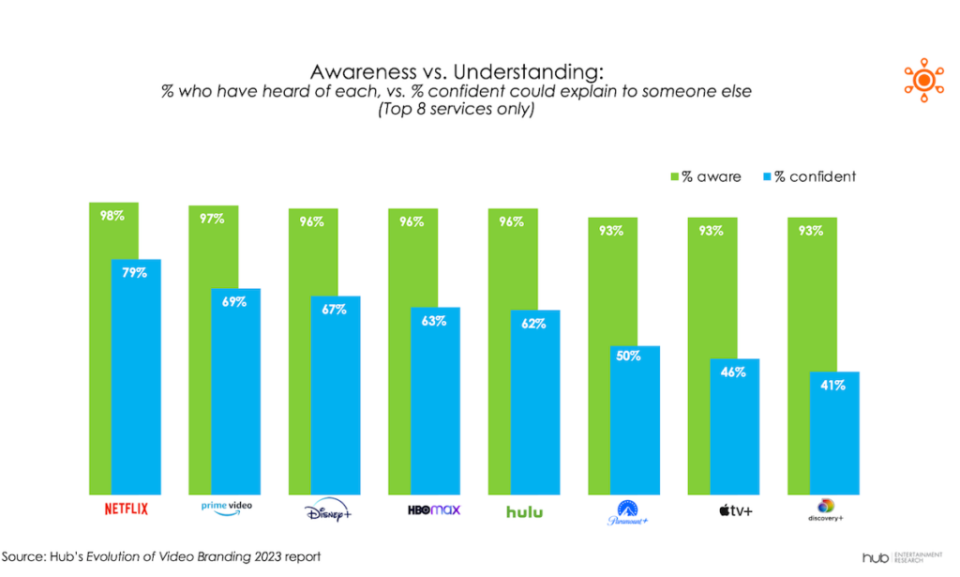
According to Hub Research’s latest annual “Evolution of Video Branding” survey, almost all respondents are aware of Apple TV+, but fewer than half felt they understood its value proposition.
Even after Apple raised the price of Apple TV+ last fall to $6.99 per month, it remains one of the cheapest major streamers. Only Discovery+’s ad-supported tier is cheaper. It reportedly spent just $6.5 billion on content in 2022, a relatively small budget compared to the outlays by Netflix, Disney and Warner Bros. Discovery.
A recent survey of 1,200 Americans conducted by UBS found that Apple TV+ “appears to have flat-lined” relative to its competitors, with just 5% of respondents citing the streamer as the “best value for the money” service despite its lower price. Over 60% of respondents said they knew of Apple’s streaming service, but just 22% reported being current subscribers, essentially flat with last year at 23% and well below competing services.
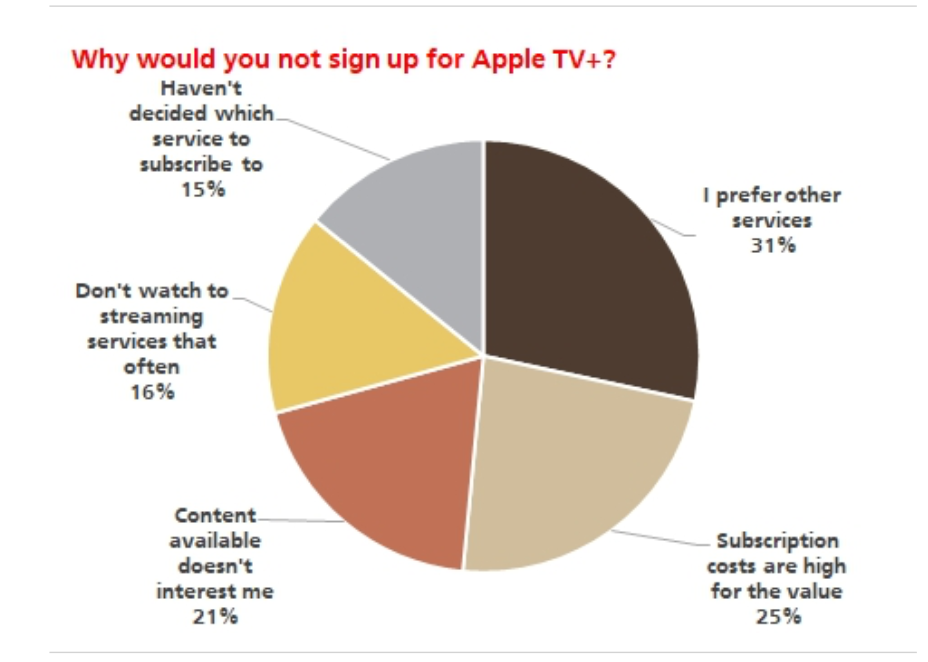
Just 39% of respondents noted they were “somewhat” or “very” likely to sign up for Apple TV+ in the next 12 months, an increase of 2 percentage points year over year but below the 42% in the bank’s 2020 survey. Roughly 25% of respondents noted that “subscriptions costs are high” relative to the value of the offering, while 31% said they preferred other streaming offerings as the reason for not subscribing to Apple TV+.
“The former is likely an impediment as the macro backdrop remains challenging while the latter captures the competitive nature of the streaming market with numerous well capitalized companies,” UBS analyst David Vogt wrote.
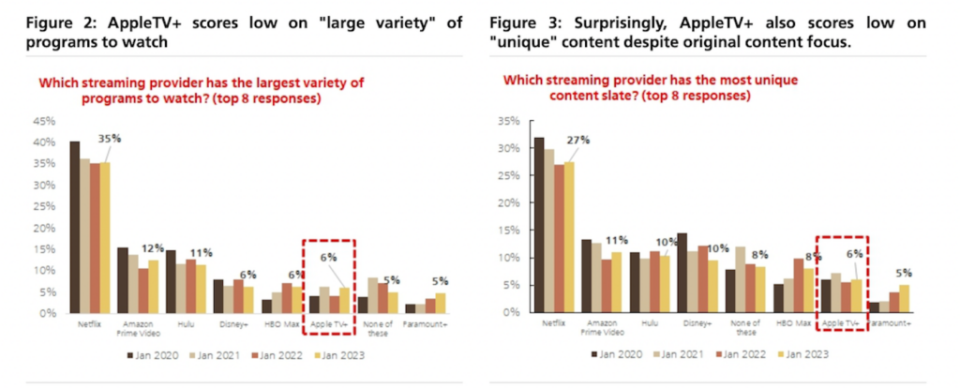
Vogt said that Apple TV+’s “limited original content slate does not appear to be resonating with viewers despite considerable critical acclaim including winning an Oscar for Best Picture” for 2021’s “CODA.”
“In the most recent survey, just 6% of respondents cited Apple TV+ as having the most ‘unique content’ compared to 27% of respondents citing Netflix and 11% and 10% respectively citing Prime Video and Hulu,” the UBS analyst noted. “Although there are likely many reasons for Apple’s low score including the incumbency advantage and brand recognition of Netflix, we believe the survey results underpin the challenges we expect Apple will likely face in this business going forward. Without subscriber scale, we believe it is unlikely to be profitable given the inherent high cost of original content.”
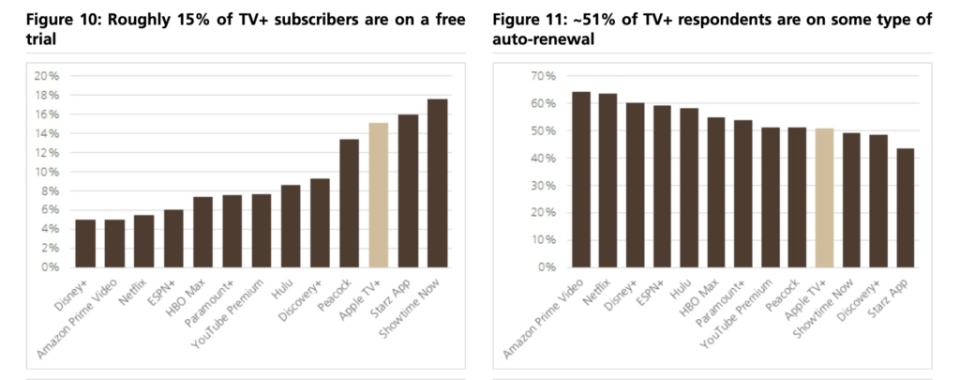
UBS estimates that Apple TV+ accounts for less than 1% of the company’s consolidated revenue. Its value may lie in being an “important contributor to reducing iPhone churn.” The company currently offers a three-month free trial to purchasers of Apple devices.
But that tie to Apple’s hardware business has a downside in terms of audience loyalty: Roughly 15% of Apple TV+ subscribers surveyed reported being on a free trial, behind only Starz and Showtime, while approximately 51% of respondents surveyed were on some type of auto-renewal. Amazon, Disney and Netflix showed much lower free-trial rates and higher auto-renewal rates.
“While the Apple ecosystem is sticky, survey responses suggest to us that TV+ faces incremental risk of churn going forward given the nature of the subscriptions relative to other offerings,” Vogt added.
Not enough hits
“Ted Lasso” led as Apple TV+’s most popular original title for 2022, followed by “For All Mankind,” “Severance,” “The Problem With Jon Stewart” and “Servant” rounding out the top five, according to Parrot Analytics, which uses a mix of data about streaming views, downloads and other forms of engagement to assess consumer demand.
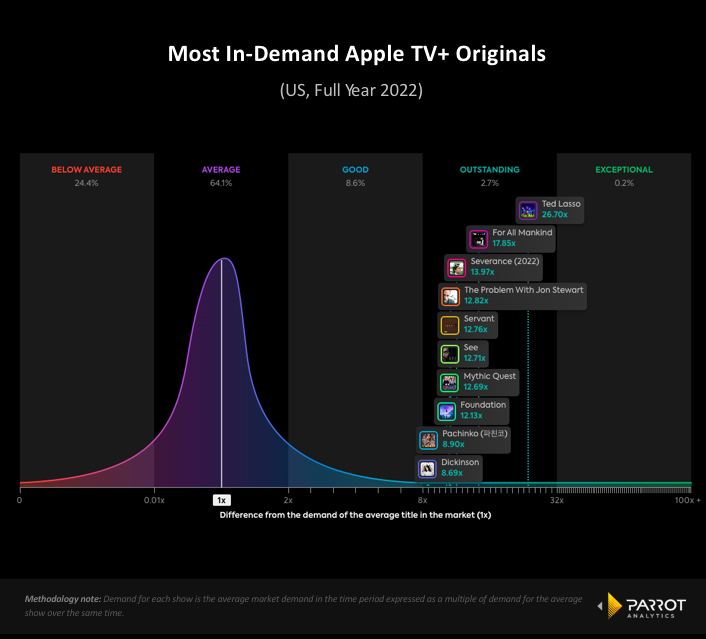
However, in examining U.S. audience demand for original programming across streaming services, Parrot found that Apple TV+ originals accounted for 6.4% of total demand in the fourth quarter of 2022, compared to Netflix’s 39.6%, Amazon Prime Video’s 11.1% and Disney’s 10.2%. Apple TV+’s share has grown since the first quarter of 2020, but is down from its 7.1% peak in the fourth quarter of 2021, shortly after the release of “CODA.”
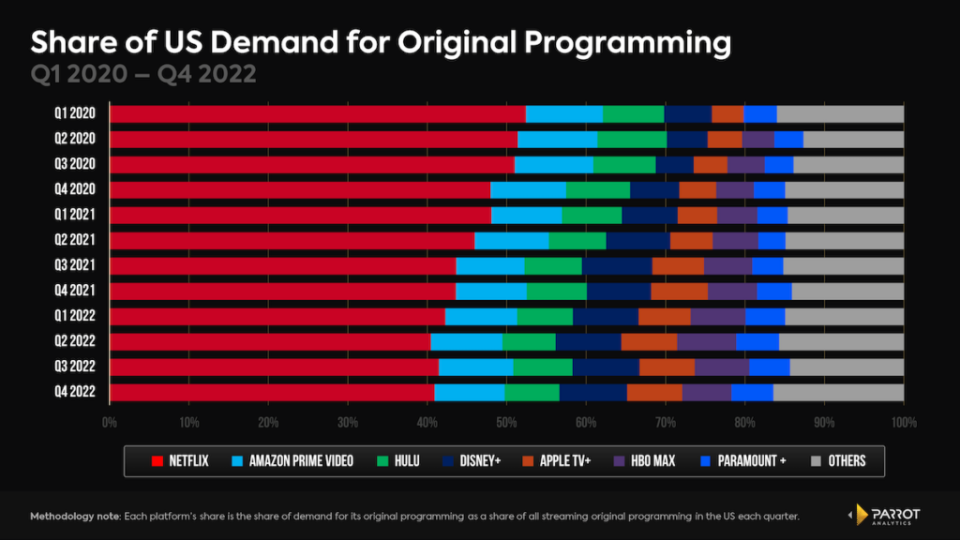
“There’s really no value that they’ve created for Apple by having this streaming service,” Gerber Kawasaki Management CEO Ross Gerber told TheWrap. “They’re just spending billions of dollars to put out shows that almost nobody watches.”
A strategic gap
Apple reported more than 900 million paid subscriptions across its services in January — ranging from hardware warranties, cloud storage, fitness programs, games and streaming music to Apple TV+ — and reported record revenue of nearly $21 billion in its services segment in its latest quarterly results released in February. But little is known about how Apple TV+ is faring against its streaming competitors as the company doesn’t break out subscriber and revenue numbers for the service.
Apple TV+ isn’t the only streamer that has mostly left Wall Street in the dark. In 2021, Amazon reported more than 200 million Prime members worldwide and said over 175 million of them streamed its film and television content, but has not offered an update since. Since Prime includes a host of benefits including free shipping and discounts on Whole Foods groceries, it’s difficult to know how much of the $139 a year Prime membership to attribute to Prime Video.
Also Read:
Streaming Could Help Broadway Bounce Back – but There Are Obstacles in the Great White Way
But Gerber pointed out that Amazon has made commitments that show it’s serious with streaming, such as its $8.45 billion acquisition of MGM.
“I think Amazon is taking a different approach than Apple by buying MGM and saying, ‘We’re gonna make movies and we’re gonna put them in theaters and we’re going to be an entertainment company.’ Apple isn’t really committed to anything they’re doing with entertainment,” Gerber argued. “As far as Apple is concerned, they just want you to keep buying iPhones and so building a deeper ecosystem is strategically part of their plan… Apple TV+’s strategy — or whatever you wanna call it — is these really expensive, targeted shows that have little social impact.”
One area where Apple does seem to be making a long-term commitment is in sports rights. On Thursday, Apple and Major League Baseball announced the return of “Friday Night Baseball,” part of a reported seven-year deal worth $85 million a year. Apple also signed a 10-year deal with Major League Soccer reportedly worth $2.5 billion over the full term. Those outlays are small compared to Apple’s overall expenses, of course.
Also Read:
Reporter Interrupts ‘Ted Lasso’ Cast’s White House Press Conference, Gets Shut Down by Karine Jean-Pierre (Video)
Moving forward, Lawrence said Apple needs to “accelerate its own development, or acquire a portfolio to make [Apple TV+] stickier.”
“They also need to lean into content that speaks to younger audiences. This is a big area of possible growth for the service,” he added. “The data shows that Gen Z underindexes by over 20% on Apple TV+ usage relative to the overall U.S. population. These younger generations want to see more diverse casting with programs that speak directly to their generation.”
Fitz-Gerald Group principal analyst Keith Fitz-Gerald argued that Apple TV+ “does not need to produce content for content’s sake” and that it should only produce work that is “good and representative of Apple’s excellence as a function of attracting others.”
“Let everybody else fight it out and expend desperately needed resources in the meantime,” he added. “Apple will be there when the fight stops and everybody else has to negotiate from a position of weakness at a time when Apple has gotten much stronger.”
Also Read:
‘Ted Lasso’ Season 3 Cast and Character Guide: Who Plays Who? (Photos)
Giegengack believes that a “largely unrealized” opportunity for Apple is to become an aggregator of all kinds of content, even beyond entertainment. Apple currently offers a subscription dubbed Apple One, which includes access to TV+, games, music, fitness programs, news and cloud storage. It doesn’t have a lot of subscribers yet, according to Hub’s research, but he sees it as an opportunity
“There’s a huge desire to simplify subscriptions — streaming video, but also anything else they subscribe to,” he said. Only a few companies — Giegengack named Apple, Amazon, Comcast and Verizon as examples — might be able to aggregate across multiple categories of entertainment. He called this strategy being a “super-aggregator.”
“Being a super-aggregator is a more fundamental differentiator than spending billions more on original content. There’s already more of that than consumers have time to watch,” Giegengack said. “In 2023, I expect we’ll see Apple and others try to capitalize on this.”
Also Read:
What Victoria Alonso’s Mysterious Marvel Exit Means as Unrest Builds at Disney